Reindeer Profile
The reindeer, native to Northern Europe and Asia, also known as the caribou, native to Northern America, is a species of deer that resides in areas in and around the Arctic.
They are split into two types, depending on the habitat that they live in, being either tundra or forest/woodland. Forest reindeer are less common and tundra reindeer are usually found in larger herds, which mass migrate at certain times of year.
There are both wild and domesticated herds of reindeer, however with caribou they are all wild.
Domesticated reindeer are herded by certain indigenous groups such as the Sámi people in Northern Norway and are used for their meat, fur, milk and antlers.

Reindeer Facts Overview
| Habitat: | Tundra, mountainous and woodland areas |
| Location: | Canada, Alaska, Greenland, Northern Europe, Russia, Northern Asia |
| Lifespan: | 15 years in the wild |
| Size: | Height – 85 – 150cm
Length – 160 – 210cm Males are slightly larger than females Southern subspecies tend to be larger than more Northern ranging subspecies. |
| Weight: | Males – 65-240kg
Females – 55-140kg |
| Colour/Appearance: | This can vary throughout the different seasons, ranging from whitish/grey in winter and shades of brown in summer. Also more Northern sub-species tend to be lighter in colour. |
| Diet: | They are herbivores feeding on grasses, mosses, lichens, mushrooms eating up to 8kg a day |
| Predators: | Wolverines, bears, eagles (on calves), lynx |
| Top Speed: | 60-80kph |
| Number of Species: | 1 |
| Threats: | Interruptions to their migration, such as fences and other human developments.
Climate change has also meant that they are more susceptible to diseases and parasites. I has also resulted in changes to migratory times which can result in calves dying as they are too young to do so. |
| Conservation status: | Vulnerable |
There are many different subspecies of reindeer, however there is a lot of differing opinion on how many there actually are.
Some of them include the Labrador caribou, porcupine/Grants caribou and peary caribou which are all found in tundra regions. Also the Finnish forest reindeer, the Newfoundland caribou and the Siberian forest reindeer all found in more woodland/forest habitats.
Reindeer have four chambers that make up their stomach and are known as ruminants (similar to cows, antelope and water buffalo). Their specialised stomachs help them digest food of a relatively low nutritional value.
In the winter, when food is scarce, they eat a lot of lichens, using their feet to scrape away the snow to get to it. In the warmer months they eat shoots, leaves and grasses, especially from birch and willow trees.
Some sub-species of reindeer live in smaller groups and have smaller ranges. Others change their group size depending on the time of year, often spending winter in smaller groups in forests and congregating in larger groups in the spring and moving to the tundra.
Some herds will travel up to 5,000km within a year and be made up of up to 500,000 individuals. Autumn also sees migrations, however these are usually in smaller groups.
This is also the time of year when rutting occurs, where males (known as bulls or stags) battle each other to mate with females (known as cows). They will lock antlers and push each other away. The bigger and stronger the male and his antlers, the more likely he is to win these battles and gain more access to females.
In late spring calves will be born, with the mother choosing a more isolated area away from possible predator threats to give birth. She will usually have one calf after a gestation period of seven and a half months, with the calf weighing up to 8kg.
Calves are on their feet pretty quickly after birth and even within a week they are subsidising the milk from their mother with a little vegetation. Reindeers are seen as mature at between 4-6 years old, however they start growing antlers at around 2 years old.
Interesting Reindeer Facts
1. Both males and females grow antlers
Reindeer are one of the only species of deer where both sexes can grow antlers. In most species it is only the males that do, however even though this is the case, not all females will grow them. 1
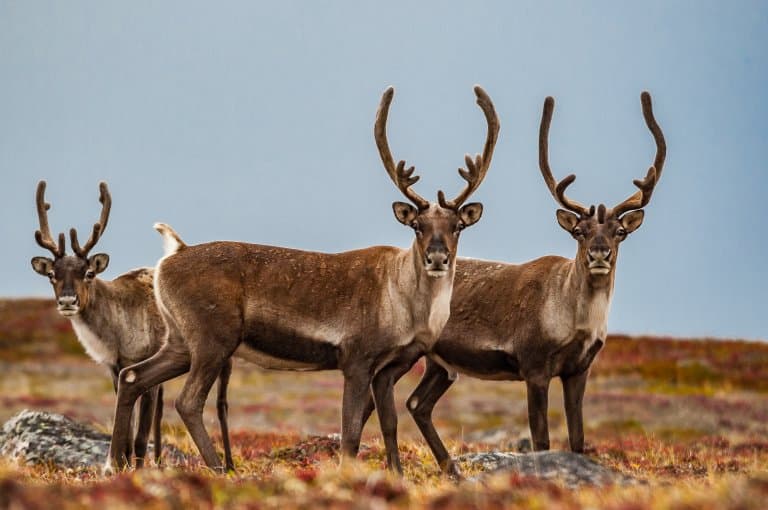
2. They have hooves that are adapted to cope with the snow
They have cloven hooves, split into two parts that spread out on the surface of the snow to help distribute their weight and stop them sinking into it.
They also help them negotiate rocks and ice underfoot and are hollow so they can dig with them in search of food in the snow.
3. Their antlers can grow up to 1.4m in length
Male antlers can grow up to 140cm in length and weigh up to 15kg. They can grow up to 44 points on their antlers and these are known as ‘tines’.
Antlers are covered by a furry skin which is known as velvet. This contains blood vessels that provide oxygen to the growing antlers/bone.
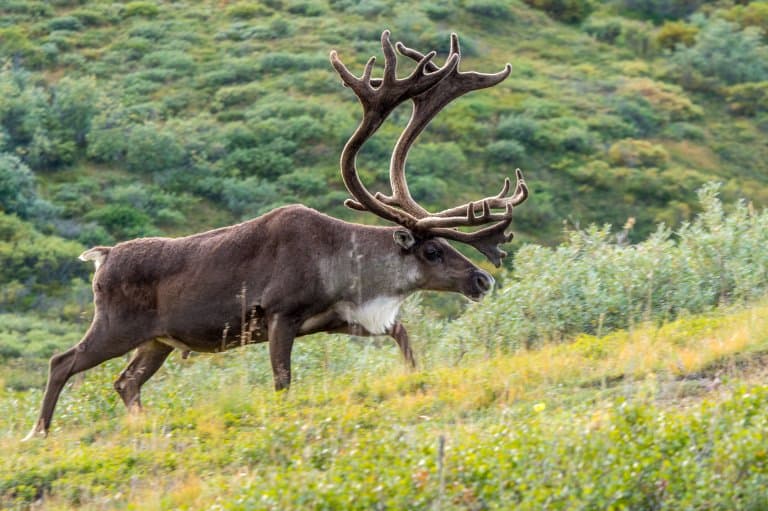
4. Reindeer can migrate 4,300 km (2,700 miles) a year!
Reindeer migrations are perhaps the longest of all land mammals, covering a remarkable distance of up to 4,300 km (2,700 miles) in a year.
This is another seasonal migration, driven by food availability, which brings them to regions of higher productivity where they can give birth and wean their young. In the Spring, the long march to their natal grounds begins, with vast herds of caribou in attendance.
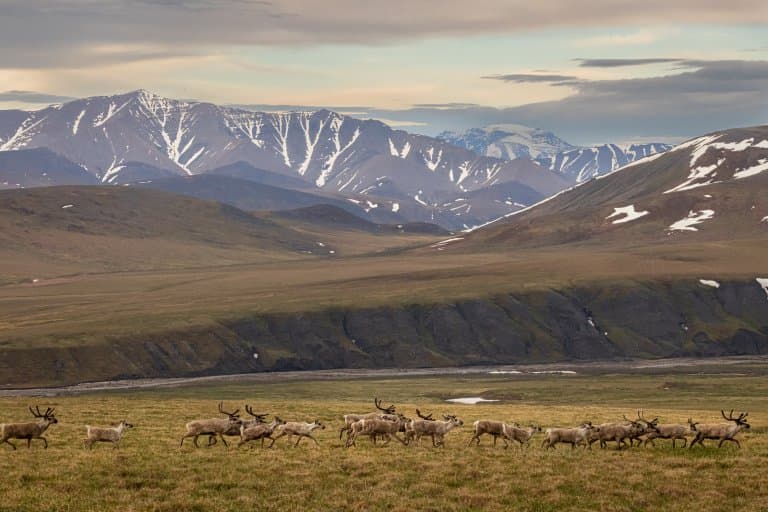
5. Alaska imported reindeer from Siberia
In the 1800s and early 1900s Alaska began to import reindeer from Siberia following the decrease in number of caribou in the region. 2
6. Their fur is ‘hollow’, which helps in freezing temperatures
Strands of their fur on the outermost layer of the pelt are hollow. This helps trap warm air and keeps them insulated overall. 3
7. Reindeer can swim
During times of migration, if necessary, reindeer will swim across bodies of water, even swimming at speeds of up to 10kph if necessary.
Large lakes or crossing wide rivers are not a problem for reindeer.
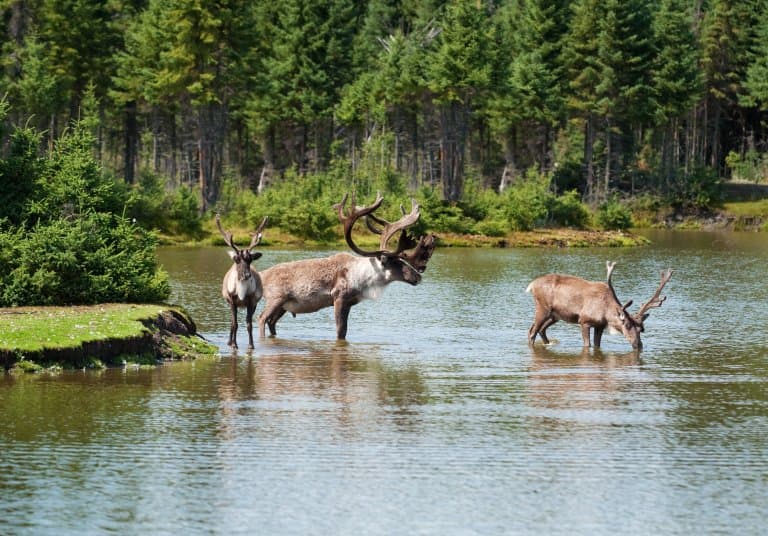
8. During the ‘rut’ males lose a lot of weight
Throughout the rutting season, male reindeer show increased levels of testosterone and aggression towards each other in an attempt to attract more females.
The rut can last for a while and because the males are so focused on this and keeping his females together, they do not eat as much, meaning that their weight drops significantly.
9. Tundra and forest reindeer fight differently
Males in large herds on the tundra tend to assess other males on the size of their antlers to help them avoid injury.
Forest males, in smaller groups fight hard to defend the smaller number of females that they have.
10. Reindeer shed their antlers
Reindeer will shed their antlers once a season to help them grow larger and stronger. Males and females usually shed them at different times of year however.
11. They are one of the fastest running land animals
Reindeer can run up to speeds of 60–80 km/h (37–50 mph). While this speed means they are just outside of the very fastest land animals on earth, they can still shift!
Even a 1 day old calf is fast enough to outrun an Olympic sprinter!
12. Reindeer click as they walk
The knees of many subspecies of reindeer are adapted to produce a clicking sound as they walk, which can be heard from hundreds of metres away.
The noise is caused by tendons slipping over bones in their feet. The level and frequency is thought to communicate the size and dominance of the reindeer to others in the herd!
13. One of the largest herds reached over 1 million reindeer
Some records show that a herd known as the Taimyr herd in Russia at one point in the early 2000s reached around 1 million individuals.
This number of individuals has decreased however, scientists believing this is linked to climate change with herds moving when calves are still too young to make the trek. Large herds are also found in areas of Canada. 4
14. Males don’t live as long as females
During the rutting season, males expend a lot of energy and by the end of it can be very weak.
This puts a lot of strain on their bodies and because of this then tend to live quite a few years less than females. Also when they are weakened they are more vulnerable to predation.
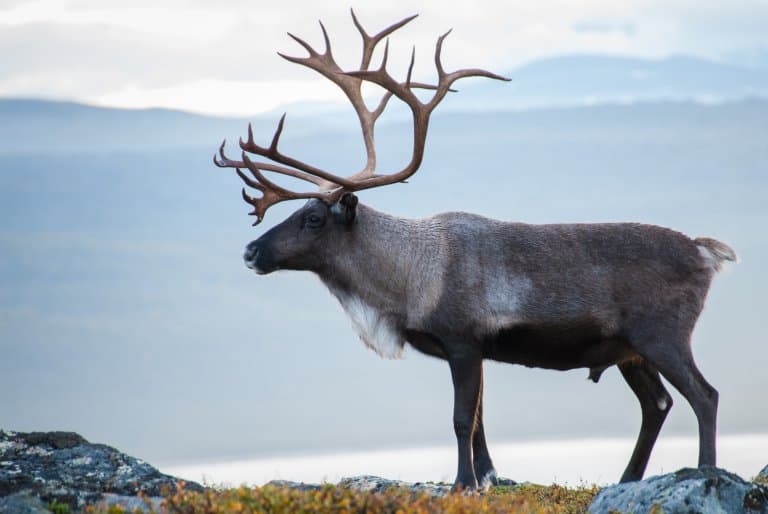
15. Reindeer do sometimes have red noses!
It’s not just rudolf that has a red nose.
Reindeer have many blood vessels in their noses. This helps increase blood flow to the nose to help keep it warm.
Reindeer do not sweat so they use this to help regulate their overall internal body temperature.
Reindeer Fact-File Summary
Scientific Classification
| Kingdom: | Animalia |
| Phylum: | Chordata |
| Class: | Mammalia |
| Order: | Artiodactyla |
| Family: | Cervidae |
| Subfamily: | Capreolinae |
| Genus: | Rangifer |
| Species: | Rangifer Tarandus |
Fact Sources & References
- (1933), “Reindeer in Alaska”, Nature.
- (2021), “Reindeer and Caribou: Facts about majestic deer”, Live Science.
- “10 BRR-ILLIANT REINDEER FACTS!”, National Geographic Kids.
- “Caribou (reindeer)”, National Geographic.
